The version I am using is 8.04 (Hardy Heron). It can be downloaded from the Ubuntu website. Before you start install Ubuntu, please take note of its
code name. My first experience with Ubuntu 7.04 (Feisty Fawn), when I try to search the packages from the website, I was confusing with the code name because Ubuntu package website using code name, such as:-
>> Ubuntu >> Packages >> feisty >> IndexBut when you get use to it, it's quite simple. First, go to the main page:
http://packages.ubuntu.com/ it will shows the code name and the version.
Here is list of the version and code name of the newer release (from 2007):
7.04 -
Feisty Fawn7.10 -
Gutsy Gibbon8.04 -
Hardy Heron8.10 -
Intrepid Ibex (currently is alpha version, will be release on October 2008)
You can also check the code name from here:
https://wiki.ubuntu.com/DevelopmentCodeNames for further updates.
Ubuntu has desktop and server edition. The different is server edition is without GUI (X server)
Well, just download and iso file (x86 or 64bit AMD architecture depending on your hardware)
and make a Ubuntu CD.
Installing Ubuntu Hardy is much more easier than the previous version. First choose the language, and then a menu will appear. You can either select "
Try Ubuntu without any change to you computer" or "
Install Ubuntu". I prefer the first option because I can test my hardware first before install.
Once inside Ubuntu, launch the
Partition Editor located at System->Administrator. After the scanning process it will shows all the harddisk in your system. If nothing appear, meaning your harddisk is not support or maybe spoil. But there is another special case. The SATAII harddisk!
SATAII harddisk normally not detect by Ubuntu! My friend first time install the Ubuntu got this problem. The way he solved this is very weird. He formatted the SATAII harddisk with NTFS, then it was detected by Ubuntu. I also got this problem too. I tried his method, not working. Then I search from the website, wow!... So many people facing this problem. Amazing... none of the expert can give a good answer! Finally I found 1... a guy said set the SATA mode to
AHCI in CMOS. OMG~ It works!! As I know, not all the BIOS has this setting. I read my motherboard manual, AHCI (Advanced Host Controller Interface) mode is an interface specification that allows the storage driver to enable advanced Serial ATA features such as Native Command Queuing and hot plug. Well, I not really understand what it meant. Whatever, as long as my harddisk can be detected by Ubuntu.
If harddisk done, now try to test your network. This is important! A lot of thing you can't do without the networking.
Network settings can be found in
System->Administration->Networking. I am using a wired connection with static IP.
Select the Wired connection and click Properties.
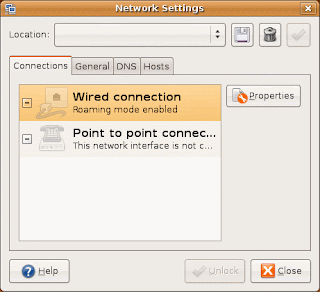
Un-tick the "Enable roaming mode", then select Static IP address.
Fill in the IP address then click OK

Next, click on the
DNS tab, and add the DNS IP address.

After setting all the IPs, just close it. Then launch the
Terminal located at Applications->Accessories and try to ping the gateway IP or any valid URL such as google.com. It works, meaning my network card is OK. So simple just like Windows. :D (I believe everyone know how to do a ping, just type
ping google.com then press enter)
Now I do the Hardware Test (System->Administration->Hardware Testing).
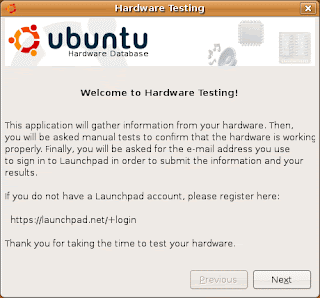
Everything passed, except the video... I see nothing... Never mind, I will try to solve this after the installation as long as my network is working. To install just simply double-click the
Install icon on the top-left side.

The installation is pretty simple, only 6 steps. First select the
language.
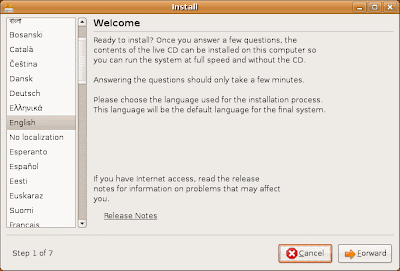
Then select the
time zone. You can direct point at map, it can be zone in and out, move left or right.
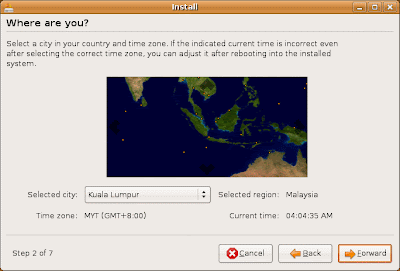
Then the
Keyboard layout.
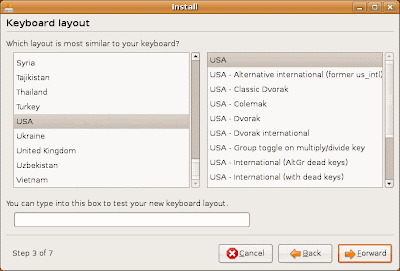
After that is
partitioning time. The simplest way is just use the default setting "
Guided - use Entire disk". Linux file system unlike NTFS or FAT, you will never see Drive A:\ C:\ D:\ ... and no need to do defragmentation. But if you want to do dual boot with Windows or partitioning the Linux directories, then you must select "
Manual". I do it manually but I will write it in another topic called "
Partition scheme"
.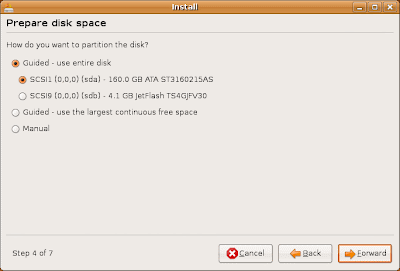 Who are you?
Who are you? Type your name (for display) , the log-in name and password. And the name of your computer.
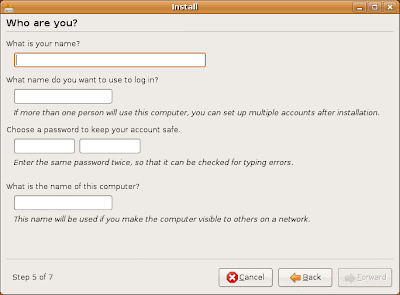 Ready to install
Ready to install. Is everything Ok, then just click
Install.
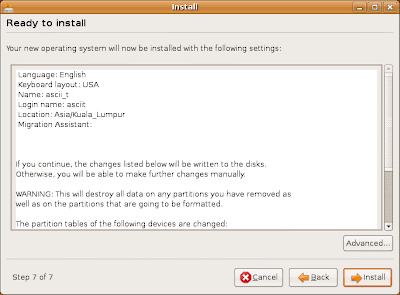
When finishing installed, a pop-up window will appear, saying that the "
Installation is complete. You need to restart the computer in order to use the new installation.". Just click
Restart now.
DONE! ~ yea ~ Ubuntu~

 I had create a share foders with read/write permission for everyone.
I had create a share foders with read/write permission for everyone. Then I test to copy file from my Win2k to this Ubuntu share, it works!
Then I test to copy file from my Win2k to this Ubuntu share, it works!















